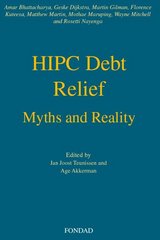HIPC Debt Relief: Myths and Reality
|
Contributing authors:
Amar Bhattacharya,
Geske Dijkstra,
Martin Gilman,
Florence Kuteesa,
Matthew Martin,
Mothae Maruping,
Wayne Mitchell,
Rosetti Nabbumba Nayenga,
Jan Joost Teunissen
Editors: Jan Joost Teunissen and Age Akkerman Summary
This book presents a thorough analysis of the successes and failures of the HIPC Initiative and provides a wide range of suggestions of what needs to be done. With a view to the future of low-income countries, the book relates the HIPC Initiative to the Millennium Development Goals and warns that debt relief can only provide a fraction of the funds required for reducing poverty and avoiding a new build-up of unsustainable debt. Will the HIPC debt relief initiative finally solve the debt burden that the Highly Indebted Poor Countries are facing since the 1980s? Is there any guarantee that a country’s external debt remains sustainable after the completion of the HIPC programme? Towards the end of the 1980s, concern about the rising debt problems of poor African countries prompted a few international experts to advocate effective debt relief to low-income countries. Early FONDAD publications contributed to putting pressure on western policymakers to consider substantial debt relief for poor countries. In 1996, the international community introduced the Heavily Indebted Poor Countries Initiative to provide a permanent exit from the repeated debt reschedulings of HIPCs in the Paris Club and bring their external debts to sustainable levels. However, in 2004 the HIPC debt problem has still not been solved. Contents
Contents, Contributors 2 Assessing the HIPC Initiative: The Key HIPC Debates 3 HIPC Debt Relief and Poverty Reduction: Uganda's Experience Kuteesa and Nayenga
4 Lessons from Eastern and Southern Africa Mothae Maruping
5 Achievements to Date and Challenges Ahead: A View from the IMF Wayne Mitchell and Martin Gilman
6 From Debt Relief to Achieving the Millennium Development Goals Amar Bhattacharya
7 Debt Relief from a Donor Perspective: The Case of the Netherlands Geske Dijkstra |
 € 12,50
Order now
February 2004 |










 Download Book as PDF
Download Book as PDF